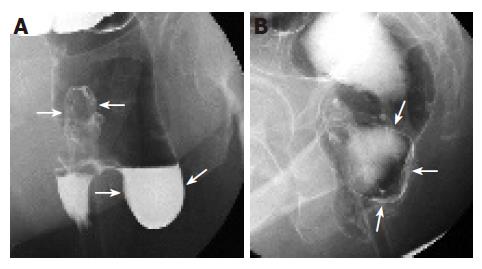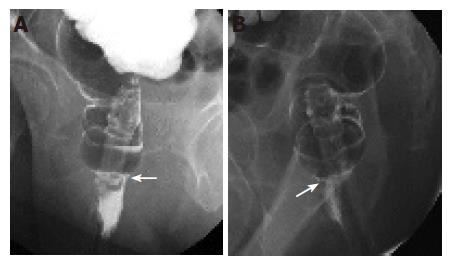Published online Dec 28, 2005. doi: 10.3748/wjg.v11.i48.7697
Revised: July 23, 2005
Accepted: July 28, 2005
Published online: December 28, 2005
The occurrence of rectal diverticula is very rare, with only sporadic reports in the literature since 1911. Symptomatic rectal diverticula are encountered even less frequently. Treatments of these complicated events range from conservative treatments to major surgical interventions. We present a hitherto unreported occurrence of isolated rectal diverticulum complicated with rectal prolapse and outlet obstruction. Delorme’s procedure resulted in subsidence of symptoms and resolution of the diverticulum. It provides a minimal invasive surgical technique to successfully address the reported malady.
- Citation: Chen CW, Jao SW, Lai HJ, Chiu YC, Kang JC. Isolated rectal diverticulum complicating with rectal prolapse and outlet obstruction: Case report. World J Gastroenterol 2005; 11(48): 7697-7699
- URL: https://www.wjgnet.com/1007-9327/full/v11/i48/7697.htm
- DOI: https://dx.doi.org/10.3748/wjg.v11.i48.7697
Cases involving complicated rectal diverticula are extremely rare[1]. But when they occur, they usually present with rectal pain and bleeding, or inflammatory lesions such as abscess formation[3,4]. The following report documents a patient who experienced outlet obstruction during defecation and episodic rectal prolapse as the initial presentation. Eventual diagnosis was complication arising from a rectal diverticulum. Surgical intervention utilizing Delorme’s procedure was successful, and is novel for the treatment of this rare and complicated event.
A 71-year-old female was admitted with a chief complaint of the sudden onset of a prolapsed mucosa through the anus during defecation on the night before admission. The protruding mucosa was reduced manually. She was nulliparous and had undergone surgical intervention for a benign tumor of unknown origin within the pelvis by a gynecologist 35 years before. Records had been lost during the subsequent postoperative period. She had experienced chronic constipation for 20 years, primarily involving an outlet obstruction for the passage of stools. She had to push her left buttock manually with her fingers to let the stool pass through the anal canal.
Upon admission, the patient was normal in general appearance except for a longitudinal surgical scar at the lower abdomen courtesy of the previous surgery. Results of physical examination were essentially normal except for the rectum. A large out-pouched pocket situated at the left lateral aspect of the rectal wall approximately 3 cm from the anal verge was digitally palpable. Sigmoidoscopy was negative. Barium enema examination showed a marked solitary 5 cm diameter diverticulum with wide-orifice neck arising from the rectal wall (Figure 1). Thus, we considered that the rectal diverticulum resulted in the accumulation of stools, causing the symptom of outlet obstruction, and subsequently had appeared as a prolapsed rectum due to the inverted rectal diverticulum protruding through the anus after excessive straining during defecation. The diagnosis of rectal diverticulum complicating with rectal prolapse and outlet obstruction was made.
The patient underwent a 50-min Delorme’s procedure under intravenous anesthesia. A circumferential incision was made through the mucosa near the dentate line. Using electrocautery, the mucosa was stripped to the apex of the prolapsed lump and excised. The denuded prolapsed muscle was then pleated with 2-0 prolene sutures and reefed up. The transected edges of the mucosa were sutured together using 3-0 chromic catgut (Ethicon, Johnson & Johnson, Medical Taiwan). The excised specimen consisted of the resected rectal mucosa with an out-pouched sacculation measuring 50 mm×70 mm in size.
Postoperatively, bowel movements occurred more than 10 times a day initially but rapidly improved to 3-4 times per day in the following days. She recovered uneventfully and obtained relief from the outlet obstruction. Repeated rectal examination revealed that the wide-orifice neck of the diverticular out-pouching had been tightly closed. She was discharged 6 d after the operation. A barium enema was repeated 2 mo later. (Figure 2) She defecated normally with 1–2 bowel movements per day during the 12 mo following the operation.
Diverticular disease occurs in the colon with great frequency. However, rectal involvement is very rare; being estimated to occur in less than 0.1% of cases[1,2]. Most patients with rectal diverticula are diagnosed by accident, as the malady is asymptomatic. Such uncomplicated rectal diverticula are clinically insignificant. However, complications associated with rectal diverticula can include rectal diverticulitis with perforation and abscess formation, diverticulitis of the midrectum, and a prolapsed rectum from an inverted rectal diverticulum[3-5]. Postinflammatory stenosis of the rectum, a rectal-vesical fistula, and an enormous fecaloma within a rectal diverticulum have also been reported as complications of rectal diverticula[6,7]. Erroneous diagnosis of carcinoma can prompt abdominal perineal resection[8].
Diverticulosis of the rectum typically occurs in the presence of colonic diverticula, especially the sigmoid segment. The factors that may contribute to rectal diverticula are still not completely understood. Possible predisposing factors include congenital anomalies such as weakness in the circumferential muscle that surrounds the rectum, primary muscle atrophy, or the absence of supporting structures such as the coccyx. Other acquired causes include relaxed rectal-vaginal septum, recurrent fecal impactions that exert pressure and cause distension of the rectum and pelvic trauma or infections leading to the weakening of the rectal wall[8,9]. In addition, Plavsic et al[2]. reported in 1995 that 2 of 27 patients with scleroderma had rectal diverticulosis without other diverticula in the rest of the colon. Loss of colonic haustrations has been reported in scleroderma and likely results in the development of colonic diverticula[10]. To our knowledge, the case we present is only the third reported case of isolated rectal diverticulum.
Rectal diverticula are typically situated along the lateral aspects of the rectum, since the complete longitudinal muscular layer of the rectum is thicker anteriorly and posteriorly compared to the lateral aspects of the wall[9]. Additionally, most rectal diverticula thus far described include all layers of the colonic wall as opposed to the more pseudodiverticula of the colon, suggesting the possibility that they occur at areas of focal weakness in the rectal wall caused by congenital or acquired origin[11]. The number of rectal diverticula per patient ranges from one to three with a diameter of 20 mm or greater compared with the remaining colonic diverticula, which typically measures less than 15 mm[9]. Rectal diverticula may also vary greatly in size with changes in intra-abdominal pressure[11].
Surgical treatments of the complicated rectal diverticula include drainage of the abscess, diverting colostomy, resection of the diverticular mass or abdominal perineal resection of the rectum. However, the Delorme’s procedure has never been reported for these complicated events. This procedure is often used for small rectal prolapse but may also be used for large ones. Our case presented with rectal prolapse, which was considered to be the result of an inverted rectal diverticulum protruding through the anal canal. Delorme’s procedure carries the advantage of a less invasive procedure that shortens the hospital stay. The patient recovered rapidly and uneventfully. Recurrence is the most common complication of this operation with an average incidence of 12% in different series[12]. Other complications such as hemorrhage, suture line dehiscence, stricture, and incontinence had ever been reported[13].
In conclusion, rectal diverticula are rare and can be easily missed by proctoscopy. They typically require no treatment because they are asymptomatic in most patients. Surgical intervention is only necessary in such patients with complicated events. Various approaches had been described in the management of different complications. Correct diagnosis preoperatively is required to prevent unnecessary surgery. In our presenting case, solitary rectal diverticulum was diagnosed by digital examination and barium enema preoperatively. Delorme’s procedure provides a minimal invasive surgery and produces excellent results.
Science Editor Guo SY Language Editor Elsevier HK
| 1. | Walstad PM, Sahibzada AR. Diverticula of the rectum. Am J Surg. 1968;116:937-939. [RCA] [PubMed] [DOI] [Full Text] [Cited by in Crossref: 25] [Cited by in RCA: 15] [Article Influence: 0.3] [Reference Citation Analysis (0)] |
| 2. | Plavsic BM, Raider L, Drnovsek VH, Kogutt MS. Association of rectal diverticula and scleroderma. Acta Radiol. 1995;36:96-99. [RCA] [PubMed] [DOI] [Full Text] [Cited by in Crossref: 7] [Cited by in RCA: 6] [Article Influence: 0.2] [Reference Citation Analysis (0)] |
| 3. | Giustra PE, Root JA, Killoran PJ. Rectal diverticulitis with perforation. Radiology. 1972;105:23-24. [RCA] [PubMed] [DOI] [Full Text] [Cited by in Crossref: 9] [Cited by in RCA: 9] [Article Influence: 0.2] [Reference Citation Analysis (0)] |
| 4. | Chiu TC, Bailey HR, Hernandez AJ. Diverticulitis of the midrectum. Dis Colon Rectum. 1983;26:59-60. [RCA] [PubMed] [DOI] [Full Text] [Cited by in Crossref: 13] [Cited by in RCA: 13] [Article Influence: 0.3] [Reference Citation Analysis (0)] |
| 5. | Edwards VH, Chen MY, Ott DJ, King GT. Rectal diverticulum appearing as a prolapsed rectum. J Clin Gastroenterol. 1994;18:254-255. [RCA] [PubMed] [DOI] [Full Text] [Cited by in Crossref: 6] [Cited by in RCA: 6] [Article Influence: 0.2] [Reference Citation Analysis (0)] |
| 6. | Wilson LB. III. Diverticula of the Lower Bowel: Their Development and Relationship to Carcinoma. Ann Surg. 1911;53:223-231. [RCA] [PubMed] [DOI] [Full Text] [Cited by in Crossref: 15] [Cited by in RCA: 15] [Article Influence: 0.8] [Reference Citation Analysis (0)] |
| 7. | Govoni AF, Smulewicz JJ. Large diverticulum of the anal canal. Case report and review of the literature on anal canal and rectal diverticula. Am J Roentgenol Radium Ther Nucl Med. 1974;121:344-347. [RCA] [PubMed] [DOI] [Full Text] [Cited by in Crossref: 11] [Cited by in RCA: 10] [Article Influence: 0.2] [Reference Citation Analysis (0)] |
| 8. | Weston SD, Schlachter IS. Diverticulum of the rectum. Dis Colon Rectum. 1959;2:458-464. [RCA] [PubMed] [DOI] [Full Text] [Cited by in Crossref: 11] [Cited by in RCA: 7] [Article Influence: 0.1] [Reference Citation Analysis (0)] |
| 9. | Damron JR, Lieber A, Simmons T. Rectal diverticula. Radiology. 1975;115:599-601. [RCA] [PubMed] [DOI] [Full Text] [Cited by in Crossref: 21] [Cited by in RCA: 15] [Article Influence: 0.3] [Reference Citation Analysis (0)] |
| 10. | Martel W, Chang SF, Abell MR. Loss of colonic haustration in progressive systemic sclerosis. AJR Am J Roentgenol. 1976;126:704-713. [RCA] [PubMed] [DOI] [Full Text] [Cited by in Crossref: 22] [Cited by in RCA: 17] [Article Influence: 0.3] [Reference Citation Analysis (0)] |
| 11. | Halpert RD, Crnkovich FM, Schreiber MH. Rectal diverticulosis: a case report and review of the literature. Gastrointest Radiol. 1989;14:274-276. [RCA] [PubMed] [DOI] [Full Text] [Cited by in Crossref: 16] [Cited by in RCA: 12] [Article Influence: 0.3] [Reference Citation Analysis (0)] |
| 12. | Nay HR, Blair CR. Perineal surgical repair of rectal prolapse. Am J Surg. 1972;123:577-579. [RCA] [PubMed] [DOI] [Full Text] [Cited by in Crossref: 24] [Cited by in RCA: 21] [Article Influence: 0.4] [Reference Citation Analysis (0)] |
| 13. | Senapati A, Nicholls RJ, Thomson JP, Phillips RK. Results of Delorme's procedure for rectal prolapse. Dis Colon Rectum. 1994;37:456-460. [RCA] [PubMed] [DOI] [Full Text] [Cited by in Crossref: 70] [Cited by in RCA: 49] [Article Influence: 1.6] [Reference Citation Analysis (0)] |










